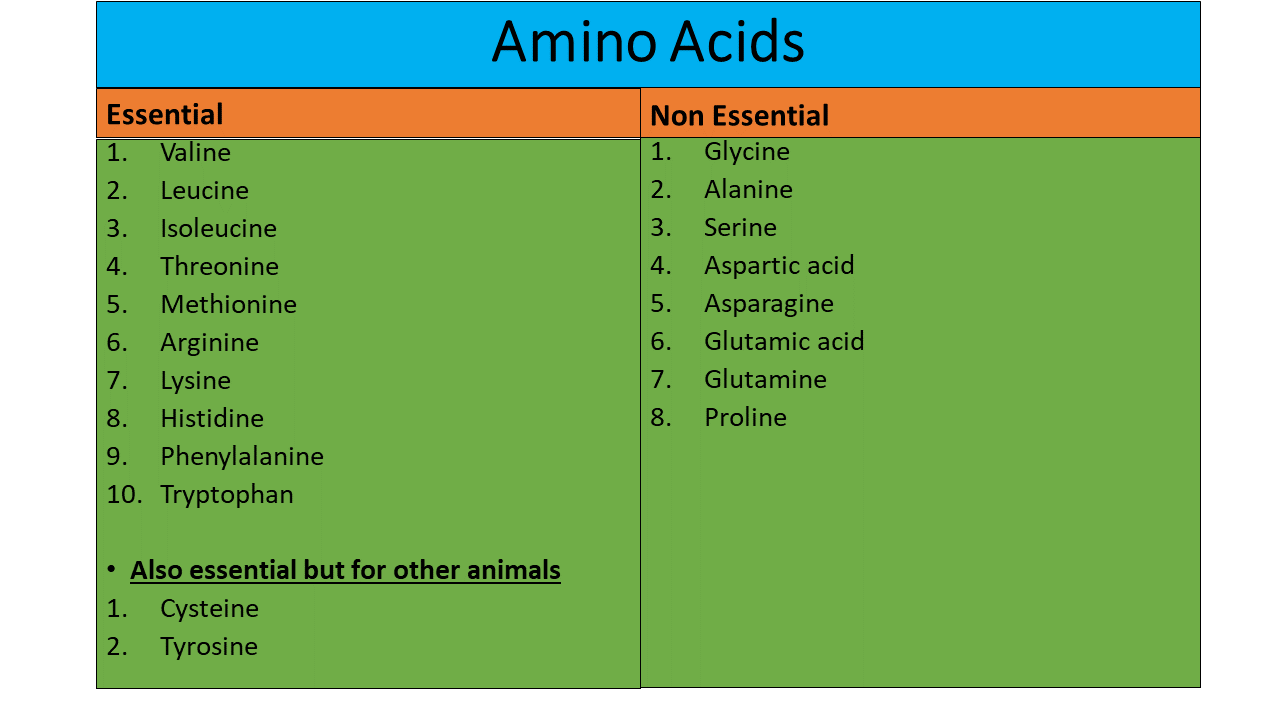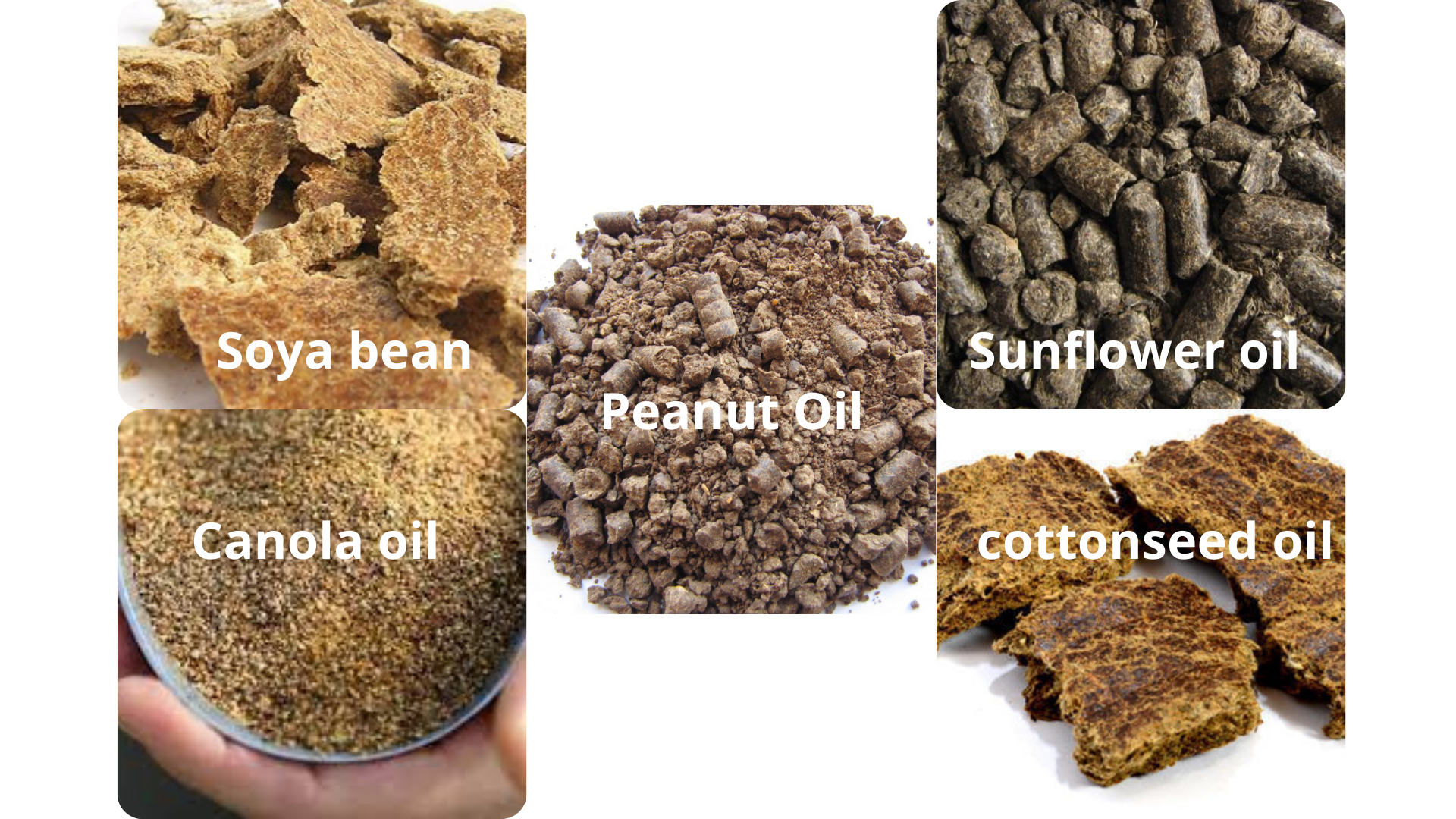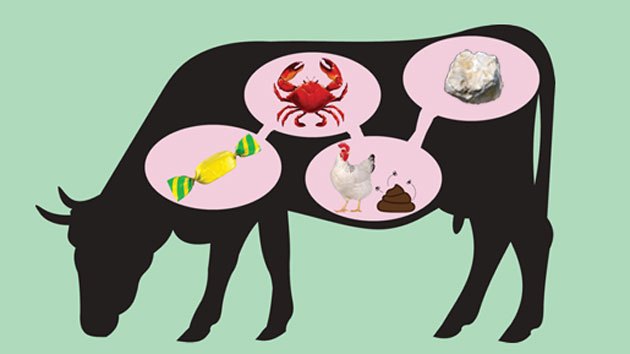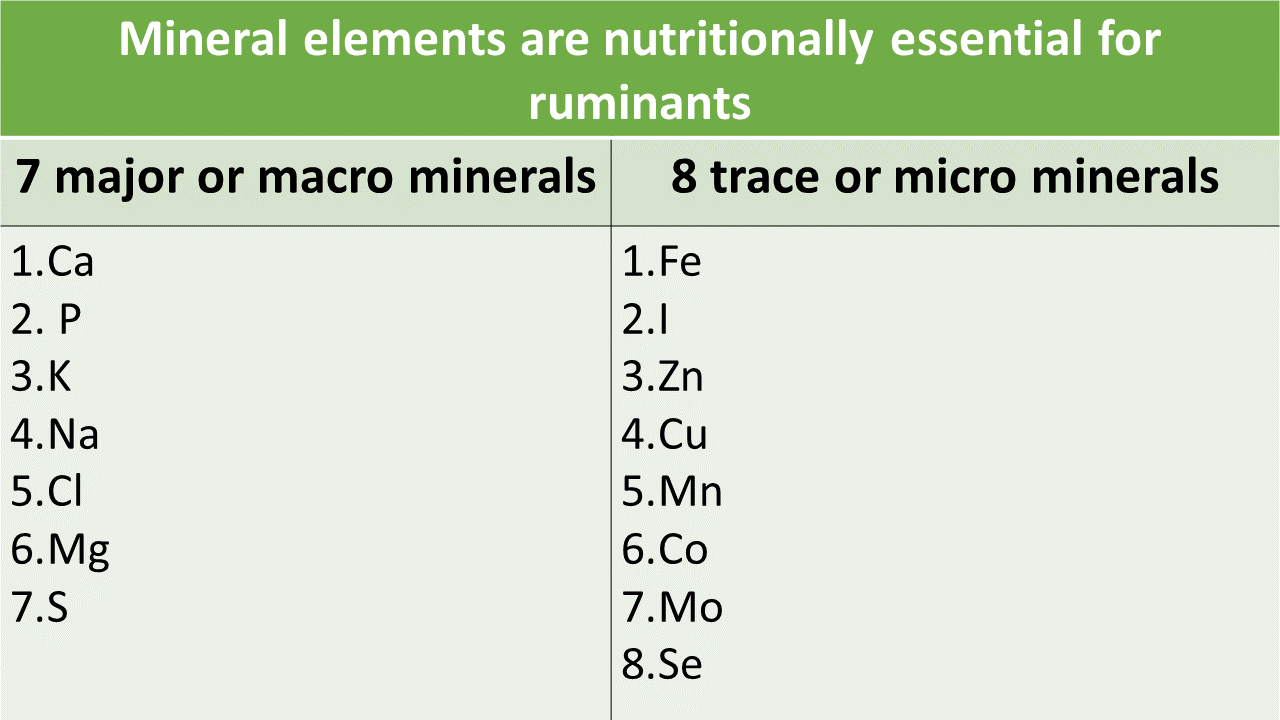You have already learned about the nutrients in animal feed. The most important requirements of animals are the supply of Energy and Protein. Protein is broken down and absorbed in the digestive tract of the animal in a simpler form, the amino acids. The amino acids are the building blocks of specific proteins and the DNA of a cell determines the ratio and quantities of amino acids that are needed to build each specific body protein. Before a protein can be built by a cell, the correct quantities and ratios of amino acids must be available to that cell to build the protein. If one of the amino acids needed is not available, the protein will not be produced, and the remaining amino acids will be broken down and used as energy.
Protein
The micro-organisms in the rumen of the ruminant can make use of two sources of nitrogen to build up their body protein. They either use free nitrogen in the form of non-protein nitrogen or protein-nitrogen from their rations. Some micro-organisms have the ability to synthesise protein out of free nitrogen and build up their own systems with these proteins. The organisms are themselves later digested by the ruminant in the abomasum. The ruminant then utilizes the synthesized microbial protein to its own benefit.
Thus, Mono-gastric (single stomach) animals are dependent on feed rations with a good quality of protein and energy. This is because the digestive tract of a monogastric animal cannot digest cellulose. Therefore, feeds high in cellulose like Lucerne and other roughages cannot be utilized as effectively by mono-gastric animals as by ruminants.
In contrast, horses and rabbits make use of lower digestive tract fermentation, where microbial activities take place in the caecum of the large intestine.
Because of these differences in the ability to digest different types of food, monogastric animals and ruminants have different feed requirements. Furthermore, the nutrient requirements (quantity and quality) of different animals differ depending on:
- Their species
- Their breed
- Their age
- Their sex
- Their production potential
- Their stage of production
- Whether they are ill or healthy
- The product they produce (whether wool, meat, milk etc.)
Most of the products produced by farm animals contain high levels of proteins in their structure for example, milk, fibre and meat. These proteins are built up from certain amino acids in different combinations that will give the protein its specific characteristics.
Amino Acids
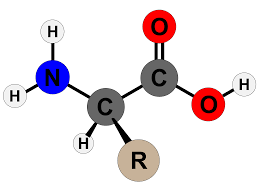
All peptides and polypeptides are polymers of alpha-amino acids. There are 20 alpha-amino acids that are relevant to the makeup of mammalian proteins. Several other amino acids are found in the body free or in combined states. These nonprotein associated amino acids perform specialized functions. Several of the amino acids found in proteins also serve functions distinct from the formation of peptides and proteins for example tyrosine is important in the formation of thyroid hormones or glutamate acts as a neurotransmitter.
The alpha-amino acids in peptides and proteins (excluding proline) consist of a carboxylic acid (-COOH) and an amino (-NH2) functional group attached at the same tetrahedral carbon atom. This carbon atom is the alpha-carbon atom. Therefore. the twenty amino acids are called the alpha-amino acids (It is not necessary to know the structures of the amino acids.) The important aspect that must be known is that there are amino acids and that these amino acids are roughly classified into essential and non-essential amino acids.
Although there are more than 20 amino acids the important ones in the rations of animals are the ones needed to build the different proteins in the body or body structure, as well as the functions that build protein out of these amino acids.
Essential Amino Acids
These are the amino acids that mono-gastric animals need in their ration to satisfy the amino acid requirements of their diet. It is important that these amino acids be included in the correct ratios to make sure that the amino acid “building blocks” are available to build certain proteins. For instance; if a wool fibre is manufactured by the cell it needs the sulphur containing amino acid methionine as a building block. So, if the diet of the animal does not supply the amino acid then wool protein cannot be formed. The essential amino acids play an important role in the synthesis of several proteins and are needed in the correct quantities in the rations of monogastric animals.
However, although the ruminant has the same amino acid requirements, the way the ration of a ruminant is digested is different. The ruminant does not only make use of his or her own enzymes for digestion but also uses microbial digestion. The microbes in the rumen can synthesize certain amino acids out of non-protein nitrogen sources. This enables the animal (ruminant) to be less dependent on external essential amino acids in their diet.
The essential amino acids are:
These alpha amino acids are also important building blocks of proteins, but the body can modify the structure of the essential amino acids to form the non-essential amino acids. The feeds of pigs, poultry and other mono-gastric animals are supplemented with the necessary amino acids when an imbalance or shortage is found in a mixed feed. Pure amino acids are expensive so the person compiling a ration will make use of natural protein rich feed sources and supplements for the initial balancing and will only supplement the pure amino acids in small quantities where it can play a big role. This is done merely to make the feed as inexpensive as possible (This is called “least cost” feed formulation). The amino acids that are supplemented will be small amounts and are mixed with the minerals and vitamins that are also small amounts.
Do you remember how to mix small amounts of feed ingredients into large amounts of mixed feed? First, mix all the small amounts of feed ingredients together and then mix it with a small amount of the larger mixed feed. Then, mix this mixture into the big amount by slowly adding it and mixing it thoroughly through the rest of the big amount.
Protein Concentrates
There are a lot of feeds that are considered “protein rich”. However, they differ in quality. As a rule, you can consider any protein feed of animal origin such as fishmeal, carcass meal and blood meal as protein supplements with a high-quality protein. The presence of essential amino acids in them is good. Dry milk powder is also a protein supplement with a good quality protein.
Definition: Protein - A good quality protein can be defined as a protein that is a good source of protein and it will supply the essential amino acids in the correct ratios.
Protein supplements of animal origin are more expensive and also less abundant.
There are also very good protein supplements available of plant origin. In the processing of certain grains and plant seeds for oil a by-product is produced that is a good protein supplement. These plant protein sources are mostly cheaper and more available than animal protein supplements. Examples include:
There are also other by-products with protein content higher than 10 % but these have a lower quality protein. These include the by-products of the milling companies such as wheaten bran and pollard.
Protein Feeds for Ruminants
Ruminants do not need such high-quality protein feeds. The micro-organisms in the rumen will degrade the feed protein and built it into their own bodies. Therefore, if you feed high quality protein feeds to ruminants you must protect these protein sources from the micro-organisms in the rumen, allowing them to pass undigested into the abomasum where they will be digested by enzymes followed by absorption of these amino acids in the small intestine.
Usually the ration of a ruminant will be balanced with protein supplements that are cheaper or with inexpensive non-protein supplements such as urea.
Non-Protein Nitrogen (NPN)
The micro-organisms in the rumen of ruminants have the ability to synthesize amino acids and therefore, proteins out of non-protein nitrogen sources such as urea. Urea supplies the nitrogen needed by the micro-organisms to synthesize amino acids. Only small amounts of urea should be added to a mixed ration since there are limits to the amount of protein that can be replaced by non-protein nitrogen. Also, urea can be poisonous if too much is used in the ration and also if the ration gets wet in rainstorms. The urea in the ration can dissolve very easily in the water and if the animal drinks the water it may die of urea poisoning. Due to the action of the ruminal microbes, ruminants are efficient at utilizing the protein within high quality roughages such as Lucerne and other legume roughages. Most of their protein requirements can be met through such roughage rations.
Alternative Protein Sources
Chicken litter is sometimes used as a protein source for ruminants because of its high urea content. However, this practise is not recommended unless the feed is sterilized, and the ruminant herd has been vaccinated against botulism.
The Supplementation of Amino Acids for Dairy Cows
In modern ruminant rations for high producing dairy cows the nutritionist includes amino acids in the ration. This is because the high producing dairy cow is not able to ingest enough of certain amino acids via her normal ration because the requirements for her production are very high and her body is physically not large enough to eat more. Because all the cows do not all produce such high yields of milk, it would be a waste to also supplement the lower producers with expensive supplementary amino acids. This creates a feed management problem in that different cows need to be fed different feeds. One way to manage this is to break the whole herd into smaller groups of cows with similar production yields. In this way the farmer can then feed the different groups of cows feed according to their production.
Another modern method of feeding individual cows is an automated system where the individual cows ration is mixed by a computer just before the milking process starts. The cow’s individual body mass and production is measured twice a day and the computer determines the mixture required. This feed is mixed as soon as the cow enters the milking stall, and is delivered to the feed bin in the milking stall while the cow is being milked. Although such systems are highly effective, they are also very costly.
Energy
Carbohydrates, fats and lipids are the main sources of energy of farm animals. The animal needs energy for maintenance, growth and production functions.
Carbohydrates
Click here to view a video that explains the role of carbohydrates in dairy cow nutrition.
Carbohydrates are found in very small quantities in animals. Most animals store carbohydrates in the cells of the liver in the form of glycogen. Plants however are a very rich source of carbohydrates. The most common place where a lot of carbohydrates are found is in the seeds of the plants in the form of starch. Some plants like sugar cane, sugar beet and even the sweet maize plant contain high quantities of sugars in their stems. Carbohydrates include:
- Starch
- Glycogen
- Cellulose
- Hemicellulose
- Sugars
- Mono-saccharides (glucose, fructose, galactose)
- Di-saccharides (sucrose, maltose, lactose)
- Poly-saccharides (hexose, pentose)
Cellulose and hemicellulose are resistant to digestive processes and their energy content is locked up and can only be utilized by animals that use microbes to help them with their digestion. Fermentation in the rumen of ruminants and the caecum and colon of horses’ and rabbits’ results in the production of short-chain fatty acids (acetate, propionate, and butyrate). These end products also result from the fermentation of sugars and polysaccharides. Fatty acids are absorbed by the reticulo-ruminal epithelium (stomach lining). Acetic acid is absorbed most rapidly, followed by propionic and butyric acids. Volatile fatty acids contribute approximately 60% of all the energy metabolised by the ruminant animal. The volatile fatty acids enter into the metabolism in various ways. Propionic acid is converted into glucose and stored as glycogen. Acetic acid may be formed into body fat, oxidised to provide energy, or converted to glucose and stored as glycogen. Butyric acid and acetic acid are important sources of milk fat.

The sugars and starches also supply energy to the farm animal (Less than 5% of the metabolizable energy is derived from these sources). As mentioned above, sugars and starches are also broken down in the rumen by microbial fermentation and volatile fatty acids are formed.
Since the microbes are responsible for digestion in the rumen, it should be remembered that it is actually the micro-organisms that are being fed rather than the animal. This is often forgotten in the feeding management of ruminants. When changes in the feed occur, the microbial population in the rumen changes. Some micro-organisms increase in number if the feed source that they prefer is provided while others will decrease in number since their feed source is not being supplied. Because of this continuous adaptation of the microbial population to the feed provided, it should be remembered that new feeds should be introduced to ruminants over a week to two-week period. This allows the microbial population time to adapt to the new feed source. If sudden complete shifts are made in the diet, the microbial population will die.
Acidosis is a disease condition resulting from poor feed management. Lactic acid bacteria occur in the rumen naturally but in very small numbers (about 0.01% of all the rumen bacteria). If a large amount of a concentrate feed (such as maize) is fed suddenly, then the lactic acid bacteria multiply very rapidly, reaching numbers as high as 30% of the total rumen microbial population. This leads to the production of excesses of lactic acid and reduces the pH in the rumen to less than 5. This massive increase in acidity leads to several metabolic disturbances in the animal such as dehydration, acidic body fluids, rumen stasis, the death of all the other rumen microorganisms, damage to the rumen wall and haemorrhaging, abscesses in the liver, formation of endotoxins, and inflammation of the intestinal tract.

The mono-saccharides are readily absorbed by simple diffusion in the small intestine. The amylase enzymes are responsible for hydrolysing the more complex sugars to their simple free derivatives. Thus, the disaccharide sucrose is converted to fructose and glucose, maltose is converted to glucose, and lactose is converted to galactose and glucose. The amylase enzymes found throughout the digestive tract digest the polysaccharides such as starch and glycogen. However, as mentioned above, cellulose and hemicellulose have beta-linked glucose units or pentose and hexose units, respectively, but no animal secretes the enzyme which can hydrolyse these beta-linkages. Thus, digestion of cellulose and hemicellulose in ruminants is dependent on microbial action.
Fats
Fat digestion begins in the duodenum (small intestine) when the triglycerides come into contact with pancreatic lipase and bile-salts. Triglycerides (the most abundant of the dietary lipids) are emulsified to glycerol and monoglycerides, free fatty acids and diglycerides. The monoglycerides and fatty acids combine with bile salts and sodium ions to form a micellar solution in the lumen of the small intestine. The lipid micelles enter the inter-microvillar spaces of the intestinal tract allowing the monoglycerides and fatty acids to enter the cells. Once inside the intestinal mucosal cells, the long chain free fatty acids and monoglycerides are re-esterified back into triglycerides. They are then coated with a layer of lipoprotein, cholesterol and phospholipid to form chylomicrons which are carried away by the lymph system. Short-chain fatty acids merely pass from the mucosal cells directly into the portal blood where they are transported to the liver as free fatty acids.
Definition: Hydrolysed – the breaking of a chemical bond by addition of a water molecule.
Minerals and Vitamins
Mineral imbalances and deficiencies can cause sub-optimal production and reproduction even when there is an abundant feed supply. At least 15 mineral elements are nutritionally essential for ruminants. There are seven major or macro minerals (Ca, P, K, Na, Cl, Mg and S) and eight trace or micro minerals (Fe, I, Zn, Cu, Mn, Co, Mo and Se). An excess of Cu, F, Mn, Mo or Se can also cause toxicities. Toxicities can also occur where excess arsenic, lead, cadmium, mercury or aluminium, occurs.
The macro elements like calcium, phosphorus and magnesium forms the structural part of the skeleton of an animal. Phosphorus also has a central role in the energy metabolism of the animal. Copper is essential for the functioning of a wide variety of enzymes and a shortage thereof results in symptoms that vary from anaemia to a lowering of fertility to a loss of crimp in wool. Cobalt forms part of Vitamin B12 which is essential for the utilization of propionic acid.
The following is a list of the essential minerals and their approximate concentrations in the body:

Some vitamins play a major role in mineral metabolism. For example, Vitamin D is important for the mineralization of calcium into the bone structure.
Phosphorus plays an important role in the transfer of energy in the body. It is also a very important part of the skeleton and along with calcium forms the main mineral components of bone.
The following is a list of the important known vitamins. They are divided into two groups:
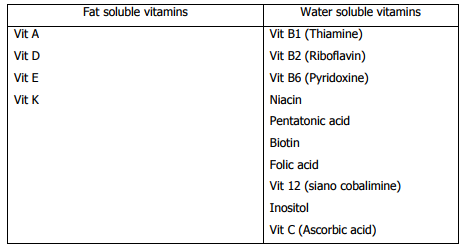
The animal body can synthesize some vitamins. These include Vitamin K and the B vitamins. All other vitamins need to be supplied via external sources. Humans, apes, other primates and guinea pigs especially have an important Vitamin C requirement, which if left unchecked can lead to a condition called scurvy.
Metabolic Diseases
Disease conditions that manifest themselves due to an imbalance of nutrient ratios are known as metabolic diseases. Some well-known metabolic diseases include:
Milk Fever
Characterised by muscle tremors, a staggering gait, and eventually paralysis and death. Occurs in heavily pregnant or lactating animals. It is caused when the calcium absorbed by the digestive tract or extracted from the bone is less than the calcium being supplied to the growing foetus in utero or to the udder for milk production. Can be reversed by supplying calcium borogluconate intravenously.
Click here to view a video that explains how to recognize milk fever?
Pregnancy Toxaemia or Ketosis (domsiekte)
Characterised by the animal being disinterested in her surroundings, is listless, has light muscle tremors, appears to be blind (there is not eye reflex), eventually kneels down and dies. This occurs in heavily pregnant animals. It is caused when the foetus takes up too much room and leaves too little room for the animal to consume the amount of energy necessary for itself and for the growth of the foetuses. This causes the animal to start breaking down stored fat to make up the deficiency in energy. Ketone bodies are formed which lead to blood acidosis. This condition can be reversed with the provision of intravenous glucose.
Click here to view a video that explains Ketosis (Acetonaemia) in dairy cattle.
Grass Staggers
Characterised by convulsive seizures where the animal lies down and paddles wildly. Caused by magnesium deficiency. Can be reversed by intravenous administration of magnesium compounds.
